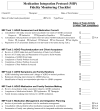Clinical Strategies for Integrating Medication Interventions Into Behavioral Treatment for Adolescent ADHD: The Medication Integration Protocol
- PMID: 25505817
- PMCID: PMC4258514
- DOI: 10.1080/07317107.2014.967631
Clinical Strategies for Integrating Medication Interventions Into Behavioral Treatment for Adolescent ADHD: The Medication Integration Protocol
Abstract
Attention-Deficit/Hyperactivity Disorder (ADHD) is highly prevalent among adolescents enrolled in behavioral health services but remains undertreated in this age group. Also the first-line treatment for adolescent ADHD, stimulant medication, is underutilized in routine practice. This article briefly describes three behavioral interventions designed to promote stronger integration of medication interventions into treatment planning for adolescent ADHD: family ADHD psychoeducation, family-based medication decision-making, and behavior therapist leadership in coordinating medication integration. It then introduces the Medication Integration Protocol (MIP), which incorporates all three interventions into a five-task protocol: ADHD Assessment and Medication Consult; ADHD Psychoeducation and Client Acceptance; ADHD Symptoms and Family Relations; ADHD Medication and Family Decision-Making; and Medication Management and Integration Planning. The article concludes by highlighting what behavior therapists should know about best practices for medication integration across diverse settings and populations: integrating medication interventions into primary care, managing medication priorities and polypharmacy issues for adolescents with multiple diagnoses, providing ADHD medications to adolescent substance users, and the compatibility of MIP intervention strategies with everyday practice conditions.
Keywords: adolescent ADHD; behavioral health; integrated care; medication.
Figures
Similar articles
-
Randomized Trial of Academic Training and Medication Decision-Making for Adolescents with ADHD in Usual Care.J Clin Child Adolesc Psychol. 2021 Nov-Dec;50(6):874-887. doi: 10.1080/15374416.2020.1716362. Epub 2020 Feb 20. J Clin Child Adolesc Psychol. 2021. PMID: 32078394 Free PMC article. Clinical Trial.
-
Pilot Evaluation of the Medication Integration Protocol for Adolescents with ADHD in Behavioral Care: Treatment Fidelity and Medication Uptake.J Emot Behav Disord. 2016 Dec 1;24(4):223-234. doi: 10.1177/1063426615611648. Epub 2015 Oct 30. J Emot Behav Disord. 2016. PMID: 34113069 Free PMC article.
-
Assessing Support for Medicine Decision Making for Youth with ADHD Who Receive Therapy [Internet].Washington (DC): Patient-Centered Outcomes Research Institute (PCORI); 2020 Sep. Washington (DC): Patient-Centered Outcomes Research Institute (PCORI); 2020 Sep. PMID: 37672618 Free Books & Documents. Review.
-
A process for developing community consensus regarding the diagnosis and management of attention-deficit/hyperactivity disorder.Pediatrics. 2005 Jan;115(1):e97-104. doi: 10.1542/peds.2004-0953. Pediatrics. 2005. PMID: 15629972
-
Managing attention-deficit/hyperactivity disorder in children and adolescents.Prim Care. 2015 Mar;42(1):99-112. doi: 10.1016/j.pop.2014.09.014. Epub 2014 Dec 18. Prim Care. 2015. PMID: 25634708 Review.
Cited by
-
Randomized Trial of Academic Training and Medication Decision-Making for Adolescents with ADHD in Usual Care.J Clin Child Adolesc Psychol. 2021 Nov-Dec;50(6):874-887. doi: 10.1080/15374416.2020.1716362. Epub 2020 Feb 20. J Clin Child Adolesc Psychol. 2021. PMID: 32078394 Free PMC article. Clinical Trial.
-
Core Elements of CBT for Adolescent Conduct and Substance Use Problems: Comorbidity, Clinical Techniques, and Case Examples.Cogn Behav Pract. 2020 Nov;27(4):426-441. doi: 10.1016/j.cbpra.2019.12.002. Epub 2020 Feb 7. Cogn Behav Pract. 2020. PMID: 34103883 Free PMC article.
-
Pilot Evaluation of the Medication Integration Protocol for Adolescents with ADHD in Behavioral Care: Treatment Fidelity and Medication Uptake.J Emot Behav Disord. 2016 Dec 1;24(4):223-234. doi: 10.1177/1063426615611648. Epub 2015 Oct 30. J Emot Behav Disord. 2016. PMID: 34113069 Free PMC article.
-
Changing Academic Support in the Home for Adolescents with Attention-Deficit/Hyperactivity Disorder: A Family-Based Clinical Protocol for Improving School Performance.Cogn Behav Pract. 2016 Feb;23(1):14-30. doi: 10.1016/j.cbpra.2014.07.002. Epub 2014 Jul 25. Cogn Behav Pract. 2016. PMID: 34103882 Free PMC article.
-
A Clinician's Guide to Co-occurring ADHD among Adolescent Substance Users: Comorbidity, Neurodevelopmental Risk, and Evidence-based Treatment Options.J Child Adolesc Subst Abuse. 2017;26(4):277-292. doi: 10.1080/1067828X.2017.1305930. Epub 2017 Apr 24. J Child Adolesc Subst Abuse. 2017. PMID: 30828239 Free PMC article.
References
-
- American Psychiatric Association. Diagnostic and statistical manual of mental disorders. 4. Washington, DC: APA; 2000. text revision.
-
- Barkley RA. Associated cognitive, developmental, and health problems. In: Barkley RA, editor. Attention Deficit Hyperactivity Disorder: A handbook for diagnosis and treatment. 3. New York: Guilford; 2006. pp. 122–183.
-
- Biederman J, Wilens T, Mick E, Faraone SV, Spencer T. Does Attention-Deficit/Hyperactivity Disorder impact the developmental course of drug and alcohol abuse and dependence? Biological Psychiatry. 1998;44:269–273. - PubMed
-
- Bukstein OG, Cornelius J. Psychopharmacology of adolescents with substance use disorders: Using diagnostic-specific treatment. In: Liddle HA, Rowe CL, editors. Adolescent substance abuse: Research and clinical advances. Cambridge University Press; 2006. pp. 241–263.
-
- Bukstein OG, Cornelius J, Trunzo AC, Kelly TM, Wood DS. Clinical predictors of treatment in a population of adolescents with alcohol use disorders. Addictive Behaviors. 2005;30:1663–1673. - PubMed
Grants and funding
LinkOut - more resources
Full Text Sources
Other Literature Sources
Medical


